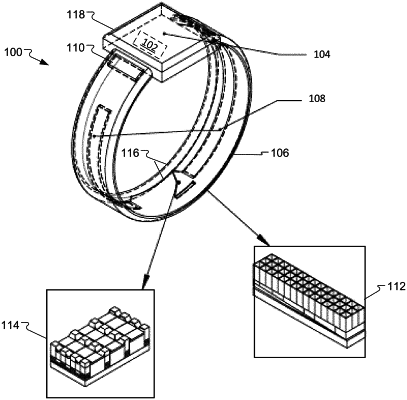| CPC A61B 5/0531 (2013.01) [A61B 5/681 (2013.01); A61B 5/7475 (2013.01); A61B 5/6831 (2013.01); A61B 2562/028 (2013.01); A61B 2562/0285 (2013.01)] | 20 Claims |

|
1. A device, comprising:
a flexible band configured to be worn on a body part of a user, wherein:
the flexible band is configured to extend at least partially around the body part; and
the body part comprises a blood vessel disposed within the body part;
a housing coupled to the flexible band;
a processing unit integrated into the flexible band or disposed within the housing, the processing unit comprising:
a processing device; or
a memory device;
a user interface integrated into the flexible band or disposed within the housing, wherein the user interface is configured to:
receive input from the user;
receive outputs from the processing unit; and
display the outputs;
a miniaturized impedance sensor integrated into the flexible band and positioned at a location along the flexible band that is adjacent to a region of the body part where the blood vessel is closest to an outer surface of the body part when the user wears the device, wherein the miniaturized impedance sensor is configured to:
take a measurement from the blood vessel; and
communicate the measurement to the processing unit, wherein the miniaturized impedance sensor comprises:
an electrode strip having a length greater than a width and thickness of the electrode strip, the electrode strip being oriented on the flexible band to be parallel to the blood vessel along the length of the electrode strip, wherein the electrode strip comprises:
parallel rows of electrode dots extending along the length of the electrode strip, wherein each electrode dot in the rows of electrode dots extends from an inside surface of the flexible band towards the body part when the user wears the device and presses into the body part when the user wears the device, and
an interstitial filler forming a continuous surface between the rows of electrode dots, wherein:
the continuous surface of the interstitial filler is curved between a top surface of at least one of the parallel rows of electrode dots to allow contact between the top surface and the user's skin;
the interstitial filler is absent from the top surface of the at least one of the parallel rows of electrode dots; and
the interstitial filler forms a continuous surface around the top surface of the at least one of the parallel rows of electrode dots and with the inside surface of the flexible band; and
an electrical trace integrated into the flexible band and configured to electrically interconnect the processing unit, the user interface, or the miniaturized impedance sensor.
|